Cataracts are opacities in the normally clear human lens which blur vision; they generally occur with advancing age or as a result of some insult eg injury, drugs, inflammation. Everybody will get a cataract if they live long enough. Here is what cataracts look like:
|
The surgery is quick and painless and vision returns rapidly.
At Eye and Retina Surgeons, it is no longer good enough to just remove a cataract and hope for a good visual result using glasses. It is part of our practice philosophy to try and give our patients good vision after cataract surgery without glasses or other visual aids.
Our aim for our patients is: Good Unaided Vision!
To achieve this requires attention to many details prior to surgery.
1. Consultation and Assessment
2. Biometry (Accurate measurements of the axial length of your eye
and the corneal curvature)
3. Selection of Intraocular Lens Implant (IOL)
4. Surgical planning
Consultation and Assessment
During your consultation, your pupils will be dilated so that the density and hardness of your cataract can be assessed.
|
This has a bearing on the selection of the machine used to remove your cataract. The harder and more mature your cataracts will usually require more sophisticated equipment. Your eye will be assessed for other conditions which may have a bearing on the outcome of your surgery. Eg glaucoma, diabetic retinopathy, age-related macular degeneration. Your refractive state will be assessed: myopia, hyperopia, astigmatism and presbyopia.
Your doctor will then advise you as to whether you will benefit from cataract surgery and discuss the options with you.
Biometry
Once the decision has been made that you will benefit from cataract surgery, measurements need to be taken of your eye so that we can choose the most appropriate lens implant to replace your cataractous lens. This is called biometry. Remember that if we take your cataract out, we are actually taking your lens out and we need to replace it with an artificial one to allow you to see again.
We have equipments (IOL Master, Sonomed and Alcon RXP) that will measure the length of your eyeball and the curvature of your cornea. With these measurements, we will then have all the information we need to make an informed decision on the most suitable lens for you and your lifestyle.
Selection of Intraocular Lens Implant (IOL)
Currently there are three major classes of lens implants:
Monofocal IOLs
 |
These IOLs are simple and yet give good visual results. Because they are monofocal in nature, in general they give good quality of vision as few compromises are made in their design. Optically speaking, all lens systems should be aspheric in design.
The Alcon Natural Aspheric Lens Implant. |
Toric IOLs
One of the recent and significant lens implant developments is the toric lens implant. Toric implants can correct pre-existing corneal astigmatism. Astigmatism is present in many of us and results in blurring of vision which usually requires glasses to correct. (Astigmatism is a condition of the eye in which the transparent cornea is shaped like a part of an egg rather than a sphere).
Hitherto, nothing could be done about astigmatism after cataract surgery apart from glasses or LASIK. The Toric implant now available has shown good results in giving good quality vision after cataract surgery without using glasses. It requires accurate implant placement.
 |
The Toric Lens Implant for correcting pre-existing astigmatism. Note the line of three dots on each side of the lens which shows the angle of the astigmatic correction.
Multifocal IOLs
One of the main problems after traditional cataract surgery with a monofocal lens implant is that the eye is normally 'set' for good distance vision. Reading requires reading glasses. |
This condition is called surgical presbyopia or 'lao hwa yen'. Physiological presbyopia occurs after the age of 40 in all patients.
Multifocal lens implants like the Tecnis or Restor implant (because it restores the vision of youth) allows a post-cataract surgery patient to see well for far as well as near without the need for glasses at all. Dr Yeoh was a user of the Restor multifocal lens implant when it was introduced to Singapore in 2004. Indeed Dr Yeoh is a trainer for many surgeons in the Asia-Pacific who are starting to use this lens.
Dr Yeoh found that more than 90% of his patients after the Restor lens was implanted did not need glasses at all.
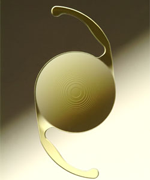 |
The Restor multifocal lens implant: note the concentric rings in the lens which confer the power of multifocality.
Patients who wish to have these more sophisticated lens implants should have healthy eyes with no other problems apart from cataract. They will then gain maximal benefit from these implants. |
Some patients are unable to have a multifocal or accommodative lens implant inserted because they have high astigmatism or extreme myopia/hyperopia. For these patients, the concept of monovision may well be effective in giving a range of far and near vision. In the monovision option, the first eye that is operated is targeted for a close to zero degree outcome which gives good distance vision, but relatively poor near vision (that’s just physics at work!) The second eye that has the cataract surgery is then targeted for about -1.5D or 150 degrees myopia. With this level of myopia, a patient can have what I term ‘social reading vision’ ie computer usage, filling in forms, reading menus and importantly putting on and taking off make up! The two eyes blend the distant and near vision to give an effective range of vision. As the disparity between the two eyes is only about 1.5D or 150 degrees, the eyes and brain are quite comfortable with this arrangement. ( A difference of up to 4D or 400 degrees is tolerable)
Note that all the three implants shown above have a light yellow tint which mimics the colour of the natural human lens and offers retinal protection from potentially harmful blue light wavelengths. It is incorporated in all these lens designs for this reason.
The ‘ART’ lens: Aspheric Restor Toric, a multifocal toric lens implant that offers good unaided vision for all distances. There are also toric multifocal implants available from a variety of other manufacturers.
The use of standard monofocal aspheric lens implants to replace a cataract and correct myopia or hyperopia is commonly practiced. In the past few years, Toric implants to correct pre-existing corneal astigmatism and multifocal lens implants to correct presbyopia (reading difficulty) have become established in an effort to reduce spectacle dependency after cataract surgery.
One group of patients was however unable to benefit from multifocal lens implants. These were patients who had significant corneal astigmatism of 1D or more. The multifocal toric lens implant or Aspheric Restor Toric lens implant (ART lens) from Alcon helps to address this problem.
The ART lens combines spherical (ie myopia and hyperopia) correction, astigmatic correction and presbyopia correction all in one lens! It is like the 'mother of all lenses'!
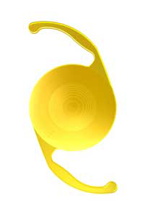 |
The Aspheric Restor Toric lens: Note the alignment dots, 3 on each side and the central diffractive rings that confer multifocality.
Dr Yeoh from ERS has used all the different types of Alcon lenses for many years and he was involved in the preliminary implantation of ART lenses from September 2010. Since then, his patients with the ART lenses implanted have all achieved very good results, with very few needing to use glasses at all. |
He was involved in launching this lens and training new surgeons in its usage in Singapore and in Malaysia, Indonesia, Thailand, Vietnam and India.
The current toric multifocal IOLs now allows most patients, even those with astigmatism to achieve a full range of vision.
Modern developments in IOLs
In 2014, a different class of intraocular implant was introduced by Abbott Medical Optics (AMO) ; this was the Symfony extended range of focus intraocular lens. This lens allows a patient to see far and intermediate vision without glasses and yet retains the quality of vision of a monofocal lens implant. It is also available with astigmatic correction as the Toric Symfony lens. With appropriate surgery and accurate targeting of the refractive outcome, many patients can be totally spectacle free with this option. The Symfony lens implant is also very useful for implanting in the second eye when one eye has already had a monofocal implant. Doing so will give a patient supplementary near vision. Few complications have been noted. Dr Yeoh now travels around the Asia-Pacific sharing his experience in using this lens implant with his colleagues.
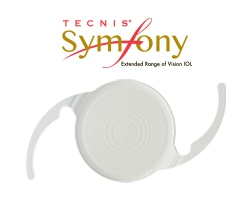
The Symfony extended range of focus lens implant.
The current lens implant that is making an impact is the Panoptix trifocal lens implant from Alcon. Introduced in Singapore in November 2015, this evolutionary design of the Restor lens implant gives a high quality full range of vision from distance to intermediate and near and early patient responses are very encouraging.
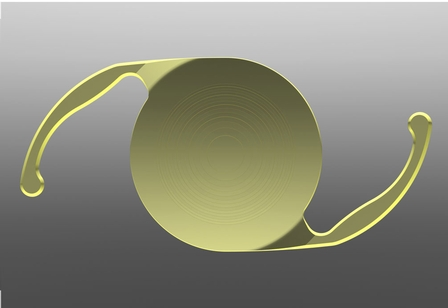
The Panoptix quadrifocal lens implant.
This lens improves on the Restor +3 by enhancing intermediate vision and dim light reading.
With so many lens implant selections available today, there is a need to properly evaluate each and every patient so that the most appropriate patient-lens implant fit is determined.
This lens improves on the Restor +3 by enhancing intermediate vision and dim light reading.
Planning for surgery
Modern cataract surgery uses ultrasound to break up a cataract into small pieces so that it can be sucked out through a tiny 2.2 – 2.6mm incision. This operation is known as phacoemulsification (phaco) of cataract with insertion of a foldable lens implant.
Traditional phaco uses longitudinal movements of a metal tipped instrument (the phacotip) to break up the nucleus. Whilst this is effective, there are a few drawbacks; the back and forth movement of the phacotip results in wasted energy on the backward stroke and unwanted heat generation potentially causing damage to the eye. This movement also sometimes caused parts of the nucleus to fly away from the phacotip during the forward stroke resulting in inefficiency and potential damage to the eye.
Another way of removing cataracts by using a design in which the phacotip moved from side to side was invented by American eyecare company Alcon. This is called Ozil or torsional Phaco. This overcame both the above problems effectively. Torsional phaco is now available in the current iteration of the phaco machine; the Centurion which features more stable fluidic platforms and more efficient phacotips.
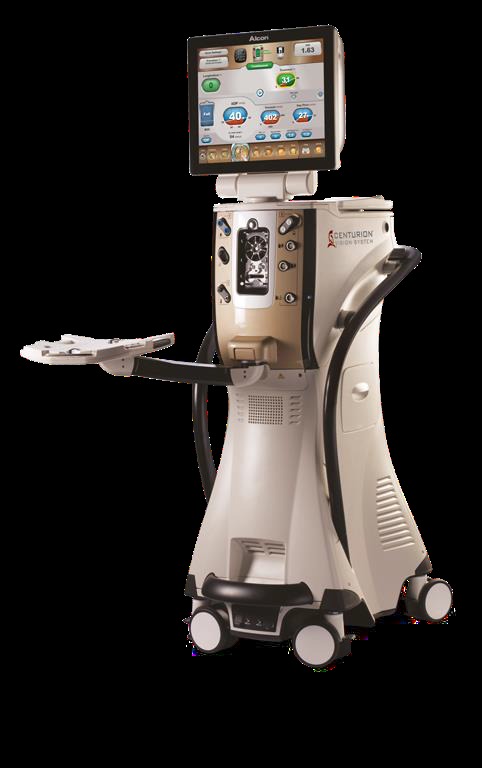
The Centurion phaco machine
This machine allows efficient removal of cataracts quickly and reliably, especially for complicated and difficult cataracts.
| View Video
|
In general, your operation will take about 15 minutes and is almost always done under local anaesthesia; regional (injection) or topical (eye-drop) as day-case surgery. An anaesthetist will stand by to monitor your general condition and deal with any medical situations that may arise. |
The operation is painless and you can expect to have clearer vision by the next morning. An exciting paradigm shift in cataract surgery technique has become increasingly popular in the last year. True laser cataract surgery is here now. Where ‘standard’ cataract surgery involves making incisions with blades and manually opening up the cataract capsule (capsulorhexis) with needles and forceps and breaking up the hard core (nucleus) of the cataract by ultrasound energy and a metal’ chopper’ , FLACS is now bladeless cataract surgery and the use of the laser to open up the cataract capsule and break up the nucleus is more accurate and uses less ultrasound energy. This results in more accurate outcomes and safety.
Eye drops will be given to prevent eye infection and inflammation.
After 3-4 weeks, your eye should be stable and a refraction will be done to see if you need glasses. If so, glasses can be made at this stage.
In the past, cataract surgery tended to be done only in elderly patients whose cataracts were ‘ripe’ and the objective was to give the cataract patient back his eye sight with the use of glasses.
This mindset has now changed because with the current techniques of removing cataracts and the current range of lens implants, cataract surgery has now become lifestyle surgery where apart from merely removing an opaque lens and replacing it with a standard lens, we can now give good vision to everyone with cataracts. Indeed, many patients with early cataracts often choose to undergo early cataract surgery so they do not need to wear glasses!